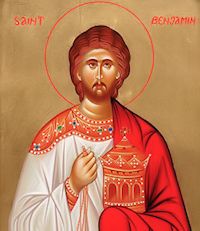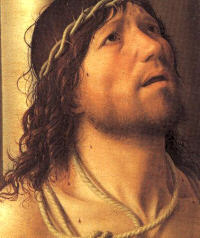Lent: March 31st
Friday of the Fifth Week of Lent
Other Commemorations: St. Benjamin, Deacon and Martyr (RM)
Free eBook:

|
| Free eBook: Liturgical Year 2023-2024, Vol. 4 |
» Enjoy our Liturgical Seasons series of e-books!
It is one week before Good Friday. Today's Mass is a further reminder of how hatred against Christ escalated in those final days before Holy Week. Fridays of Lent have a special penitential quality. —The Vatican II Weekday Missal
The Roman Martyrology commemorates today St. Benjamin (d. 424), a martyr of Persia (modern Iran) and a deacon in the persecution conducted by the Sassanid rulers Yazdigerd I and his son Varahran. He was tortured and impaled.
Meditation
What do we do for the salvation of souls? It is true that we pray for one another, offer a few words of comfort, and do each other slight favors; but we do little more. Christ was more generous. He endured the crowning of thorns and dragged the heavy cross to Calvary. We pamper our bodies as if they were our last end. We prefer to have our heads crowned with laurels and roses. We are impatient and consider ourselves unfortunate whenever we are called on to carry a mere splinter of the cross of Christ. Are we one in spirit with Him?
Now, during Passiontide, we must begin to love and treasure pain and suffering. In the cross, in suffering, in our crucifixion with Christ, we shall find salvation. For Him and with Him we should bear all the slight injustices committed against us. For Him we should suffer freely and willingly the unpleasant and disagreeable things that occur to us. But our faith is weak. We flee from the cross instead of holding it dear, instead of loving it and welcoming it as our Savior did.
What St. Paul says of many Christians of his day is equally true of many in our time: "For many walk, of whom I have told you often (and now tell you weeping) that they are enemies of the cross of Christ. Whose end is destruction; whose God is their belly; whose glory is in their shame; who mind earthly things" (Phil. 3:18 f.).
—Excerpted from The Light of the World by Benedict Baur, O.S.B.
St. Benjamin
 The Christians in Persia had enjoyed twelve years of peace during the reign of Isdegerd, son of Sapor III, when in 420 it was disturbed by the indiscreet zeal of Abdas, a Christian Bishop who burned the Temple of Fire, the great sanctuary of the Persians. King Isdegerd threatened to destroy all the churches of the Christians unless the Bishop would rebuild it.
The Christians in Persia had enjoyed twelve years of peace during the reign of Isdegerd, son of Sapor III, when in 420 it was disturbed by the indiscreet zeal of Abdas, a Christian Bishop who burned the Temple of Fire, the great sanctuary of the Persians. King Isdegerd threatened to destroy all the churches of the Christians unless the Bishop would rebuild it.
As Abdas refused to comply, the threat was executed: the churches were demolished, Abdas himself was put to death, and a general persecution began which lasted forty years. Isdegerd died in 421, but his son and successor, Varanes, carried on the persecution with great fury. The Christians were submitted to the most cruel tortures.
Among those who suffered was St. Benjamin, a Deacon, who had been imprisoned a year for his Faith. At the end of this period, an ambassador of the Emperor of Constantinople obtained his release on condition that he would never speak to any of the courtiers about religion.
St. Benjamin, however, declared it was his duty to preach Christ and that he could not be silent. Although he had been liberated on the agreement made with the ambassador and the Persian authorities, he would not acquiesce in it, and neglected no opportunity of preaching. He was again apprehended and brought before the king. The tyrant ordered that reeds should be thrust in between his nails and his flesh and into all the tenderest parts of his body and then withdrawn. After this torture had been repeated several times, a knotted stake was inserted into his bowels to rend and tear him. The martyr expired in the most terrible agony about the year 424.
—Excerpted from Saints and Angels
Highlights and Things to Do:
- Read more about St. Benjamin:
- If you are named after St. Benjamin you can find a medal of him at the Catholic Company.
- St. Benjamin is also honored in the Eastern Orthodox Church and the Byzantine Rite Eastern Catholic Churches on October 13.

Friday of the Fifth Week of Lent
Station with Santo Stefano Rotondo al Celio (St Stephen's Rotunda at the Coelian Hill):
The Station, at Rome, is in the church of St. Stephen on Monte Celio (the Coelian Hill). The church is dedicated first to St. Stephen, the First Martyr, but is also dedicated unofficially to St. Stephen of Hungary. This is the Hungarian national church. This church is southeast of the Colosseum, off the usual beaten path. The actual site of the church was occupied by a set of barracks housing Roman soldiers. The earliest church was consecrated by Pope Simplicius between 468 and 483. Its architecture is unique in the Late Roman world and the oldest example of a circular church, often thought that it was modelled on the Anastasis of the Holy Sepulchre in Jerusalem. Although the inside is circular, the exterior is on a cruciform plan. The church has undergone various periods of ruination, disrepair, and restoration. The relics of the first martyr were never in the church.
Besides being one of the original churches in the round, another key feature is found on the walls of the church, decorated with numerous frescoes, portraying 34 scenes of martyrdom, commissioned by Gregory XIII in the 16th century. Each painting has a titulus or inscription explaining the scene and giving the name of the emperor who ordered the execution, as well as a quotation from the Bible.
For more information on Santo Stefano Rotondo al Celio, see:
For further information on the Station Churches, see The Stational Church.







